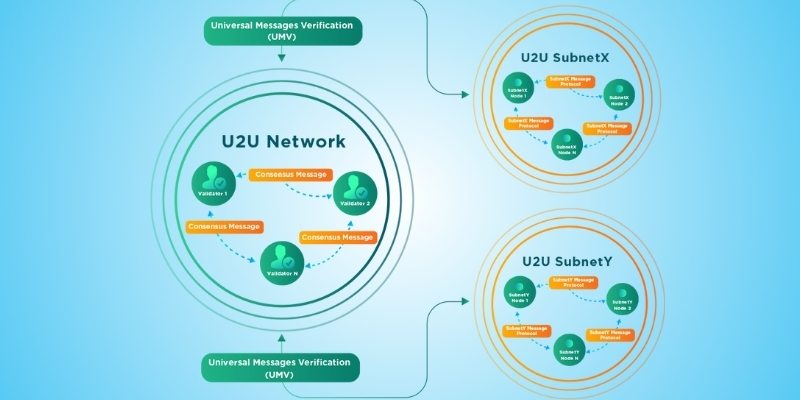How Does U2U Network Work? A Deep Dive into Its Revolutionary Architecture
The blockchain industry is evolving rapidly, and the U2U Network stands out as a next-generation Layer-1 blockchain designed to tackle scalability, interoperability, and security challenges. With its innovative approach to Decentralized Physical Infrastructure Networks (DePIN) and high-performance infrastructure, U2U is redefining how decentralized applications (dApps) operate. But how does U2U Network work? This article explores its core components, consensus mechanisms, and real-world applications, offering a comprehensive look at its groundbreaking technology.
Contents
The Foundation: U2U Chain and DAG Architecture
At the heart of the U2U Network lies the U2U Chain, a Layer-1 blockchain that leverages a Directed Acyclic Graph (DAG) architecture. Unlike traditional blockchains that process transactions sequentially in blocks, DAG enables parallel transaction processing. This structure significantly boosts throughput, achieving up to 17,000 transactions per second (TPS) per shard and potentially 73,000 TPS in ideal conditions. Transaction finality is remarkably fast, taking less than 650 milliseconds, making U2U ideal for high-demand dApps.
So, how does U2U Network work to achieve such performance? The DAG architecture allows transactions to be validated concurrently, reducing bottlenecks and ensuring scalability. This is particularly valuable for DePIN projects, where real-time data processing is critical, such as in IoT, healthcare, or decentralized cloud storage.

Helios Consensus: Powering Security and Efficiency
The U2U Network employs the Helios Consensus Mechanism, a hybrid of Asynchronous Byzantine Fault Tolerance (aBFT) and Delegated Proof of Stake (DPoS). This consensus model ensures both security and efficiency, addressing common blockchain challenges.
aBFT: Guarantees network reliability even if up to one-third of nodes fail or act maliciously, making U2U highly resilient.
DPoS: Enables token holders to delegate their stake to validators, reducing energy consumption compared to Proof of Work (PoW) systems. This aligns with environmental, social, and governance (ESG) priorities.
By combining these mechanisms, U2U delivers a secure, energy-efficient network that supports rapid transaction validation. This is a key aspect of how does U2U Network work to provide a robust platform for developers and users alike.
U2U Subnets: Modular Scalability
One of U2U’s standout features is its subnet architecture, which enables developers to create customized, independent sub-networks tailored to specific use cases. Each subnet operates as a self-contained blockchain, inheriting the main network’s security and consensus protocols. This modularity is critical to understanding how does U2U Network work for large-scale applications.
Subnets distribute computational loads, ensuring unlimited scalability and preventing congestion on the mainnet. For example, a subnet could be dedicated to IoT devices, healthcare data management, or decentralized storage, each optimized for its unique requirements. Even if the mainnet experiences downtime, subnets remain operational, enhancing reliability.
The network supports three types of nodes within subnets:
Master Nodes: Handle transactions and cross-network operations.
Validator Nodes: Ensure data integrity using Trusted Execution Environments (TEE) and Fully Homomorphic Encryption (FHE).
Edge Nodes: Contribute resources like bandwidth, CPU, or storage, earning rewards.
This node structure underpins U2U’s ability to support resource-intensive DePIN projects, such as its flagship U2DPN (Decentralized Private Network).

Interoperability and DePIN Integration
Interoperability is a cornerstone of U2U’s design. The network integrates the Inter-Ledger Protocol (ILP), enabling seamless communication and asset exchange between U2U and other blockchains or traditional financial systems. This cross-chain compatibility ensures U2U can integrate with the broader Web3 ecosystem and real-world applications.
A key application of this interoperability is U2U’s focus on Decentralized Physical Infrastructure Networks (DePIN). How does U2U Network work in the DePIN space? By transforming devices into nodes that share resources like bandwidth, computing power, or storage, U2U creates decentralized ecosystems. The U2DPN, a decentralized VPN, exemplifies this, serving over 113,000 sessions and sharing 69,000+ GB of bandwidth globally. Users contribute unused bandwidth and earn passive income, demonstrating U2U’s practical utility.
Staking, Governance, and the U2U Token
The U2U token (total supply: 1 billion) powers the network’s economy. It serves multiple purposes:
Staking: Token holders stake U2U to secure the network, earning 5–15% APY depending on conditions.
Transaction Fees: Used to pay for network operations and cross-chain transfers.
Governance: Enables community-driven decision-making through voting on proposals.
This token ecosystem is central to how does U2U Network work as a decentralized, community-governed platform. Staking via DPoS ensures energy efficiency, while governance fosters transparency and inclusivity.
Developer Tools and Ecosystem Growth
U2U Network provides a robust suite of tools to support developers. It is EVM-compatible, allowing Ethereum-based dApps to be ported with minimal effort. Developers can use languages like Python, Go, Rust, and TypeScript, and leverage tools such as:
- U2UScan: A blockchain explorer for transaction tracking.
- The Graph: For efficient data indexing.
- Bridge Technology: For cross-chain asset transfers.
The U2U Super App, with thousands of downloads, enhances user interaction with the ecosystem. With over 80 dApps and 1 million users, U2U’s ecosystem is thriving, supported by partnerships like GPU.net for decentralized computing.
Real-World Impact and Future Potential
The U2U Network’s real-world impact is evident in its DePIN applications and growing adoption. The U2DPN alone showcases its ability to deliver scalable, privacy-focused solutions. Backed by $13.8M in funding from investors like KuCoin Ventures and led by experienced professionals, including CEO Luu Tran (former CTO of KardiaChain), U2U is well-positioned for growth.
So, how does U2U Network work to drive Web3 innovation? By combining DAG architecture, Helios Consensus, subnet scalability, and DePIN integration, U2U offers a high-performance, secure, and interoperable platform. Its focus on real-world applications, from decentralized VPNs to IoT and healthcare, positions it as a leader in the blockchain space.
For more information, explore the official U2U Network documentation at docs.u2u.xyz.